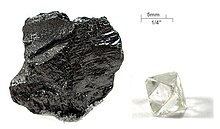From Wikipedia, the free encyclopedia
Side by side comparison {{Infobox element }} {{Infobox element/sandbox }}
Chemical element with atomic number 6 (C)
Carbon, 6 C Graphite (left) and diamond (right), two allotropes of carbon
Allotropes graphite , diamond and more (see Allotropes of carbon )Appearance graphite: black, metallic-looking diamond: clear
Atomic number (Z ) 6 Group group 14 (carbon group) Period period 2 Block p-block Electron configuration [He ] 2s2 2p2 Electrons per shell 2, 4 Phase at STP solid Sublimation point 3915 K (3642 °C, 6588 °F) Density (near r.t. ) amorphous: 1.8–2.1 g/cm3 [ 1] 3 3 Triple point 4600 K, 10,800 kPa[ 2] [ 3] Heat of fusion graphite: 117 kJ/mol Molar heat capacity graphite: 8.517 J/(mol·K) Oxidation states common: −4, −3, −2, −1, 0, +1, +2, +3, +4 Electronegativity Pauling scale: 2.55 Ionization energies 1st: 1086.5 kJ/mol 2nd: 2352.6 kJ/mol 3rd: 4620.5 kJ/mol (more ) Covalent radius sp3 : 77 pm2 : 73 pmpm Van der Waals radius 170 pm Spectral lines of carbonNatural occurrence primordial Crystal structure graphite: simple hexagonal Crystal structure diamond: face-centered diamond-cubic Thermal expansion diamond: 0.8 µm/(m⋅K) (at 25 °C)[ 6] Thermal conductivity graphite: 119–165 W/(m⋅K) Electrical resistivity graphite: 7.837 µΩ⋅m[ 5] Magnetic ordering diamagnetic [ 4] Molar magnetic susceptibility diamond: × 10−6 3 /mol[ 7] Young's modulus diamond: 1050 GPa[ 6] Shear modulus diamond: 478 GPa[ 6] Bulk modulus diamond: 442 GPa[ 6] Speed of sound thin rod diamond: 18,350 m/s (at 20 °C) Poisson ratio diamond: 0.1[ 6] Mohs hardness graphite: 1–2 CAS Number atomic carbon: 7440-44-0 graphite: 7782-42-5 diamond: 7782-40-3 Antoine Lavoisier [ 8]
Category: Carbon references
Chemical element with atomic number 6 (C)
Carbon, 6 C Graphite (left) and diamond (right), two allotropes of carbon
Allotropes graphite , diamond and more (see Allotropes of carbon )Appearance graphite: black, metallic-looking diamond: clear
Atomic number (Z ) 6 Group group 14 (carbon group) Period period 2 Block p-block Electron configuration [He ] 2s2 2p2 Electrons per shell 2, 4 Phase at STP solid Sublimation point 3915 K (3642 °C, 6588 °F) Density (near r.t. ) amorphous: 1.8–2.1 g/cm3 [ 1] 3 3 Triple point 4600 K, 10,800 kPa[ 2] [ 3] Heat of fusion graphite: 117 kJ/mol Molar heat capacity graphite: 8.517 J/(mol·K) Oxidation states common: −4, −3, −2, −1, 0, +1, +2, +3, +4 Electronegativity Pauling scale: 2.55 Ionization energies 1st: 1086.5 kJ/mol 2nd: 2352.6 kJ/mol 3rd: 4620.5 kJ/mol (more ) Covalent radius sp3 : 77 pm2 : 73 pmpm Van der Waals radius 170 pm Spectral lines of carbonNatural occurrence primordial Crystal structure graphite: simple hexagonal Crystal structure diamond: face-centered diamond-cubic Thermal expansion diamond: 0.8 µm/(m⋅K) (at 25 °C)[ 6] Thermal conductivity graphite: 119–165 W/(m⋅K) Electrical resistivity graphite: 7.837 µΩ⋅m[ 5] Magnetic ordering diamagnetic [ 4] Molar magnetic susceptibility diamond: × 10−6 3 /mol[ 7] Young's modulus diamond: 1050 GPa[ 6] Shear modulus diamond: 478 GPa[ 6] Bulk modulus diamond: 442 GPa[ 6] Speed of sound thin rod diamond: 18,350 m/s (at 20 °C) Poisson ratio diamond: 0.1[ 6] Mohs hardness graphite: 1–2 CAS Number atomic carbon: 7440-44-0 graphite: 7782-42-5 diamond: 7782-40-3 Antoine Lavoisier [ 8]
Category: Carbon references
References
These references will appear in the article, but this list appears only on this page.
^ Lide, D. R., ed. (2005). CRC Handbook of Chemistry and Physics (86th ed.). Boca Raton, Florida: CRC Press. ISBN 0-8493-0486-5 ^ Haaland, D (1976). "Graphite-liquid-vapor triple point pressure and the density of liquid carbon". Carbon . 14 (6): 357–361. doi :10.1016/0008-6223(76)90010-5 . ^ Savvatimskiy, A (2005). "Measurements of the melting point of graphite and the properties of liquid carbon (a review for 1963–2003)". Carbon . 43 (6): 1115–1142. doi :10.1016/j.carbon.2004.12.027 . ^ Magnetic susceptibility of the elements and inorganic compounds , in Handbook of Chemistry and Physics 81st edition, CRC press. ^ "Material Properties- Misc Materials" . www.nde-ed.org . Retrieved 12 November 2016 .^ a b c d e Properties of diamond , Ioffe Institute Database^ Weast, Robert (1984). CRC, Handbook of Chemistry and Physics . Boca Raton, Florida: Chemical Rubber Company Publishing. pp. E110. ISBN 978-0-8493-0464-4 ^ Senese, Fred (2000-09-09). "Who discovered carbon?" . Frostburg State University. Retrieved 2007-11-24 . ^ "Standard Atomic Weights: Carbon" . CIAAW . 2009.^ a b Prohaska, Thomas; Irrgeher, Johanna; Benefield, Jacqueline; Böhlke, John K.; Chesson, Lesley A.; Coplen, Tyler B.; Ding, Tiping; Dunn, Philip J. H.; Gröning, Manfred; Holden, Norman E.; Meijer, Harro A. J. (2022-05-04). "Standard atomic weights of the elements 2021 (IUPAC Technical Report)" . Pure and Applied Chemistry . doi :10.1515/pac-2019-0603 . ISSN 1365-3075 . ^ "Standard Atomic Weights: Carbon" . CIAAW . 2009. 



